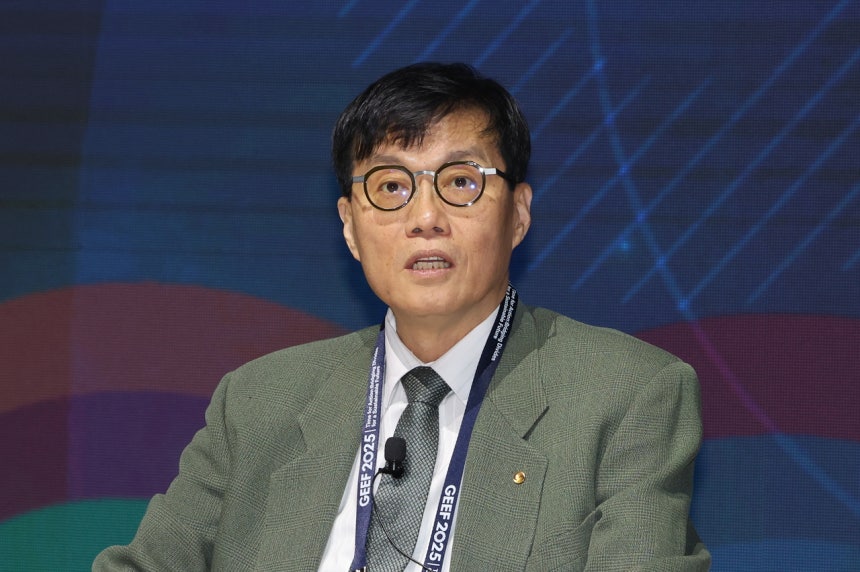“A Birth Rate of 1.4 Required for Growth Until 2050
Need to Address Low Birth Rate and Concentration in the Capital Area”
,
 |
| Rhee Chang-yong, Governor of the Bank of Korea, is delivering a keynote speech at the 7th Global Engagement & Empowerment Forum (GEEF 2025) held at Yonsei University’s Centennial Hall in Seodaemun-gu, Seoul, on the 14th. [Yonhap] |
Rhee Chang-yong, Governor of the Bank of Korea, emphasized again that if the low birth rate continues, Korea may enter negative growth starting in 2050. He suggested fostering a few key cities and implementing a region-based proportional selection admission system as solutions to the low birth rate issue.
Regarding climate change, he expressed concern by suggesting that the ‘squall’ phenomenon might have reached Korea, and warned that by the 2030s, apple cultivation will become difficult in areas other than the mountainous regions of Gangwon Province. He highlighted the need for more proactive climate crisis measures, such as reducing the total carbon emission quota.
In his keynote speech at the ‘Global Engagement & Empowerment Forum (GEEF) 2025’ held at Yonsei University’s Centennial Hall in Seodaemun-gu, Seoul, on the 14th, Rhee stated, “If the total fertility rate remains at 0.75, it would be difficult to avoid negative growth after the 2050s. However, if the birth rate is at a level of 1.4, positive growth could be maintained even in the 2050s.”
He continued, “The national debt-to-GDP ratio is 46.9% as of 2023, but if the birth rate remains at 0.75, the national debt ratio will surge to 182% in 50 years (2073).” He further explained, “Currently, four young people support one senior, but 50 years later, one young person will have to support one senior.”
To overcome the low birth rate crisis, he pointed out the need to address the ‘concentration in the capital area’ phenomenon, which exacerbates competition and anxiety among the younger generation.
In terms of population, GDP, and jobs, the concentration in Korea’s capital area exceeds 50%. In contrast, such concentration is around 5% in the U.S. and Germany, 10-20% in the UK and Italy, around 20-30% in France, and about 30% even in Japan.
Rhee advocated for the introduction of a ‘region-based proportional selection system,’ citing the underlying college entrance exam system as a reason for the concentration in the capital area. He had previously emphasized the need for a region-based proportional selection system multiple times.
Rhee noted that “Among students entering Seoul National University, which is recognized as the top prestigious university, 32% are from Seoul, twice the proportion of the school-age population in Seoul (16%). Particularly, the proportion of students from the three affluent districts in Gangnam is 12%, three times the school-age population proportion (4%), indicating that private education in Gangnam serves as a major gateway to top universities.”
He added, “As demand for relocation to areas with excellent educational environments and top university admission rates increases, it intensifies population concentration in the capital area and the rise in housing prices in Seoul, further exacerbating the low birth rate issue in a vicious cycle.”
Additionally, Rhee emphasized overcoming climate change at the forum that day. He commented, “By observing this summer’s heavy rainfall patterns, it feels as if the squall phenomenon, usually occurring in Thailand or South America, has arrived in Korea,” pointing out that the frequency of extreme rainfall occurrences has more than doubled compared to the 1970s.
He also addressed agricultural issues such as the cultivation of apples. He mentioned, “With climate change progressing faster than expected, by the 2030s, it will be almost impossible to cultivate high-quality apples domestically except in the mountainous regions of Gangwon Province.” He added, “What was controversial today may be naturally accepted reality ten years from now,” stressing the need to enhance carbon emission regulations to address climate change. Hong Tae-hwa Reporter.

